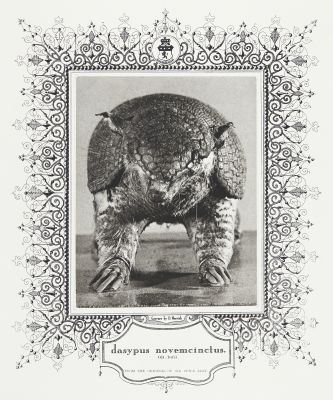
Title
vulpes vulpes (Red Fox)Artist
Morrish, David (Canadian, b.1953)Publication
The GalleryDate
1999Process
PhotogravureAtelier
DeadCat Press, Ontario, CAImage Size
35 x 30 cm
In this series of portraits, the image of an animal is an icon, noble and proud, but subverted through the use of this less-than-perfect taxidermy. These specimens undermine and ridicule our preconception of the ideal; the noble animal as anthropomorphized by the popular media. They are the pawns of tradition and formal convention. I select, then photograph each subject on the basis of how they represent an expressive moment which is poignant and sometimes funny. These moments are not fleeting, however, but are frozen by the methodology, choices, and skills (or lack thereof) of the taxidermist. The animal could play no part in how it was posed. In the prints, these animals are presented using the same formal conventions used in portraits of noble aristocrats as found in the 18th or 19th Century bookplate, complete with archaic decorative border. Their taxonomic title, as ascribed to them by science, adds a layer of information which, like the titles of the peerage, is pompous, formal and with origins often unrelated to the subject. The presentation places the print in a large overly ornate multilayered guilt and black frame. The allusion to portraits in The Great Hall or as part of an honor roll is intentional, adding to the sense of sublime absurdity.We are currently being bombarded with the cult of the animal from such varied sources in popular culture as animal rights activists, wildlife protectionists, National Geographic Magazine, Walt Disney, the Discovery Channel, logos, cartoons and toys, commercials, and movies. The Gallery exaggerates the pomposity of this form of wildlife aggrandizement. I do not criticize the roles we create for animals in our society but question anthropomorphization as a way to "understand" or identify with animal species. With The Gallery I hope to make the viewer recognize the so-called "personality" of each specimen, then reproach themselves for being so crass to fall into the same trap as demonstrated and encouraged by so many popular forms of animal (mis)representation. The viewer is then forced to consider how animals really exist in direct contrast to these unfortunate creatures.
David Morrish—Retired Full Professor of Art, lives in Prince Edward County, Ontario and co-author with Marlene MacCallum of Copper Plate Photogravure, Focal Press, 2003. Morrish has exhibited traditional copper-plate photogravure prints since 1996, nationally and internationally: Japan, Taiwan, China, S. Korea, Thailand, Sweden, Ireland, USA, England, Italy, and Canada. His artist’s book-works, GAZE and DIED use copper-plate photogravure and letterpress under his imprint: DeadCat Press. DIED includes a rare four-plate CMYK color copper-plate photogravure. Recent research explores animal and human mortality, faux biography, provenance, collections, and the museum archive through the construction of an immersive Wunderkammer, The Lyric Cranium.
